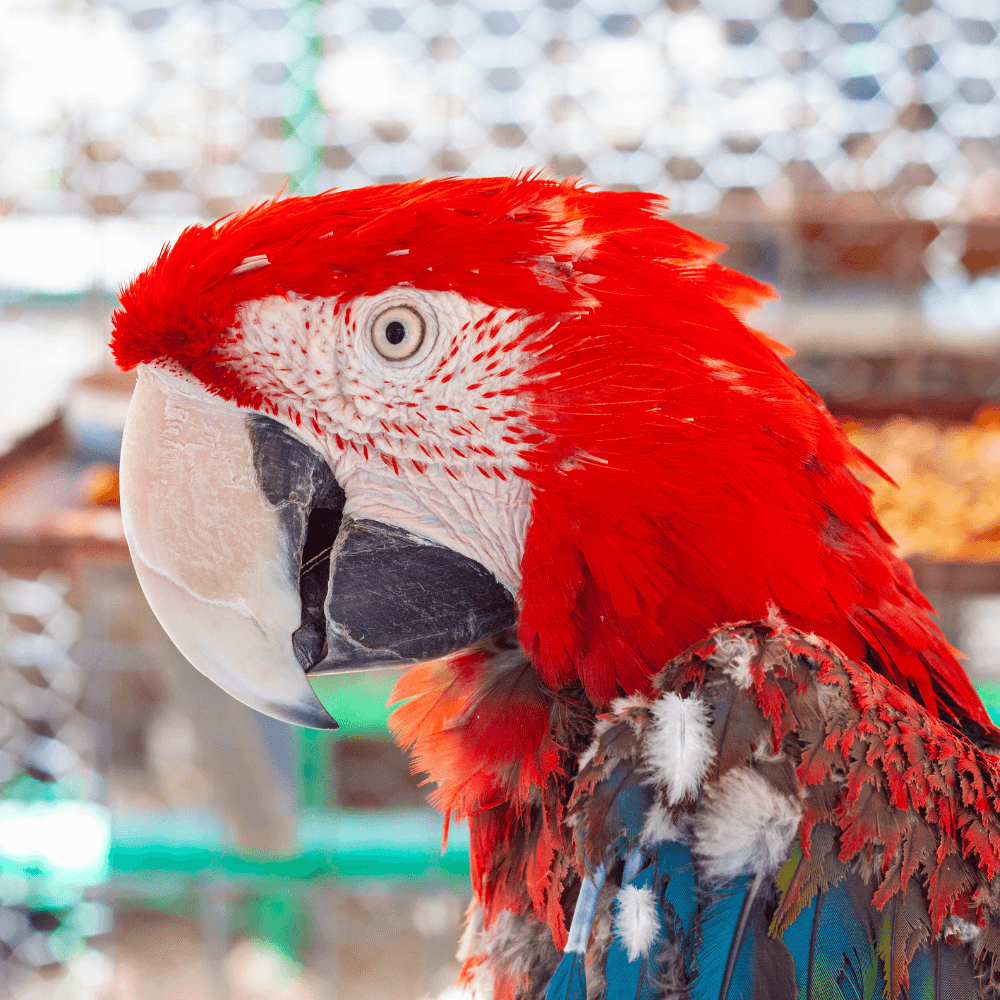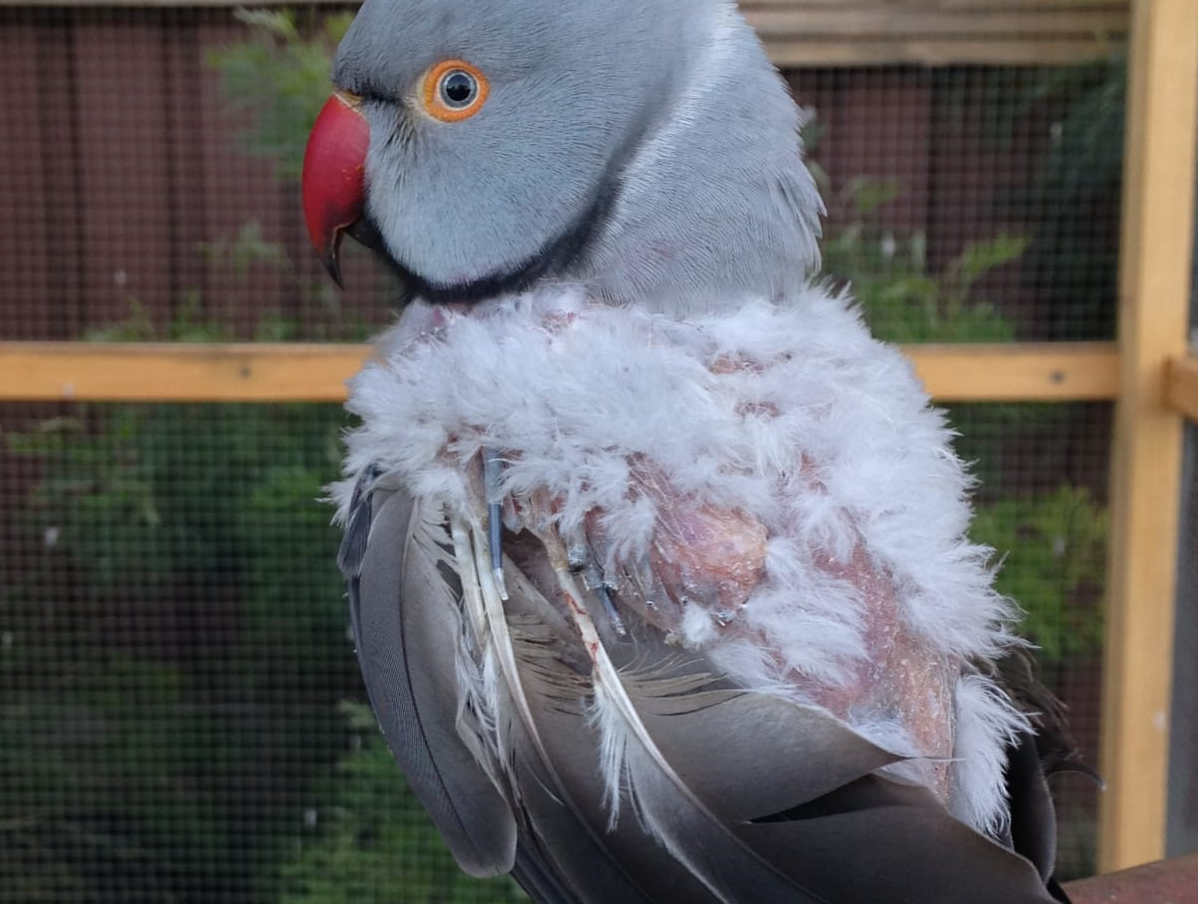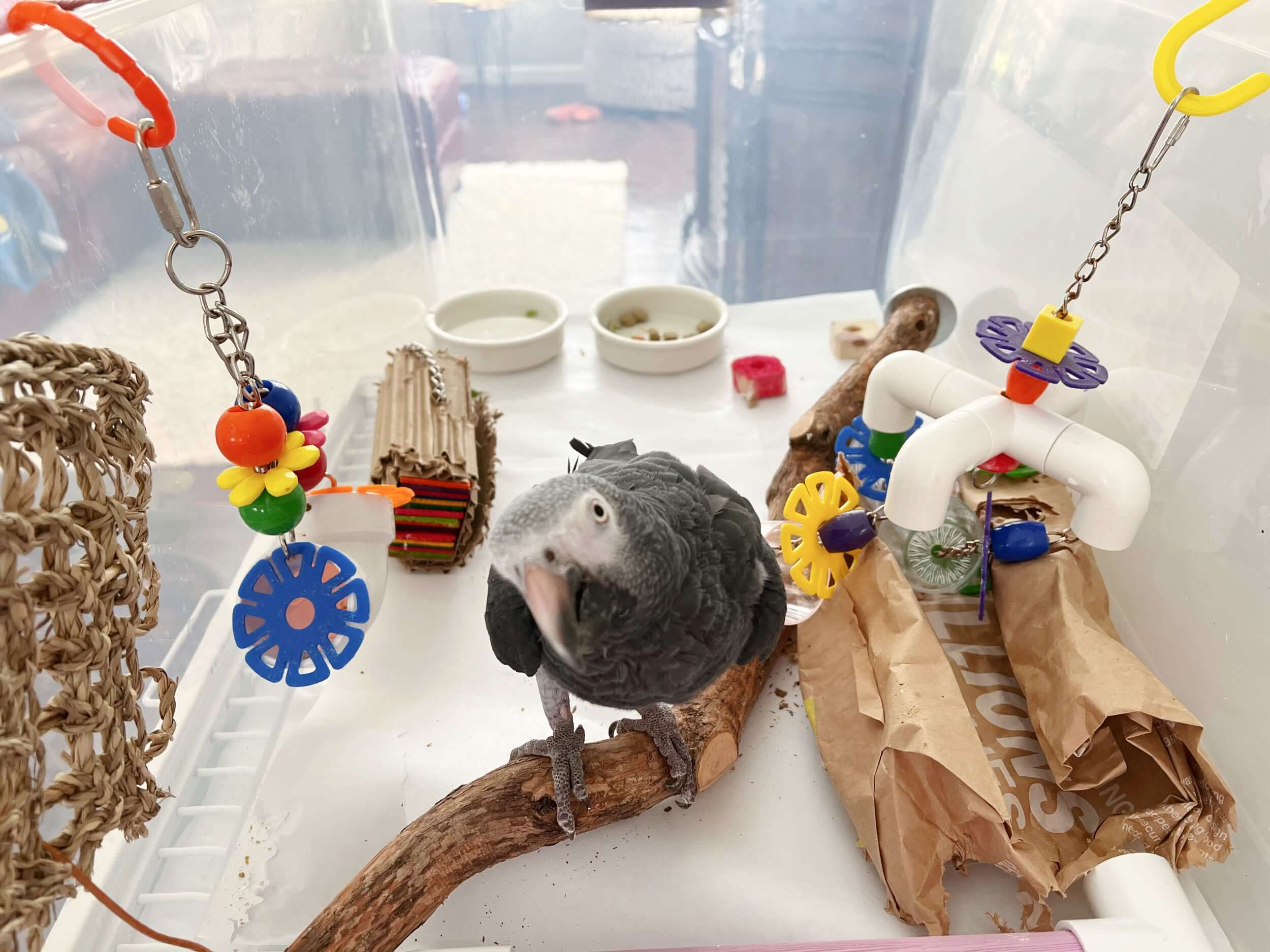Revised Jun 19, 2024
Table of Contents
Feathers are really important for your bird's health and beauty. In this blog post, we'll talk about why birds lose feathers and how you can help them grow back strong and healthy. Keep reading to learn some great tips and check out our feather growth FAQ's to see how you can make your bird's feathers the best they can be!
Understanding Feather Growth
Birds need a diet full of vitamins, minerals, and proteins to keep their feathers healthy and strong. Just like us, they need good food to look and feel their best. Fresh fruits, vegetables, and high-quality bird food can give your feathered friend the nutrients they need for beautiful, vibrant feathers.
Sometimes, birds need a little extra help, and that's where avian nutraceuticals come in. Omega-3 fatty acids and biotin are fantastic for supporting feather growth. These special nutraceuticals can help feathers grow back faster and stronger, making your bird look and feel amazing.
Remember, a balanced diet and the right avian nutraceuticals can make a huge difference in your bird's feather health. Always check with your vet before adding new nutraceuticals to your bird's diet. With the right care, your bird's feathers will shine and be the envy of all the other birds!
Stress-Free Environment
Regrowing feathers can be really stressful for your bird, so it's super important to help them stay calm and relaxed. One way to do this is by ensuring their environment is just right. Make sure your bird has proper lighting, the right humidity levels, and a clean cage. A well-maintained habitat helps reduce stress and supports healthy feather growth.
Another great way to minimize stress is by keeping your bird entertained. Birds love toys and activities that keep their minds busy and bodies active. Provide a variety of toys, like puzzle feeders and swings, to keep your bird from getting bored. Regular interaction and playtime with you can also make a big difference, giving them the social engagement they crave.
Lastly, make sure your bird feels safe and secure. Avoid sudden changes in their environment and try to keep a consistent routine. This stability can really help reduce anxiety and stress, making the feather regrowth process easier for your bird. By focusing on these simple steps, you'll help your feathered friend stay happy and healthy as they grow their beautiful new feathers.
Regular Health Monitoring
Regular veterinary visits are crucial for keeping your bird healthy, especially when it comes to their feathers. A vet can catch and treat any underlying health issues that might be causing feather damage or loss. These check-ups ensure that your bird is getting the right care and nutrition they need to grow strong, healthy feathers.
Monitoring your bird for signs of feather damage or loss is also important. If you notice any changes, like bald spots or excessive plucking, address the problem promptly. Early intervention can prevent small issues from becoming big problems, helping your bird stay happy and well-feathered.
What Causes a Bird to Lose Feathers
Molting
Explanation of the molting cycle and how it varies by species.
Molting is a natural process where birds shed old feathers to make way for new ones. This cycle varies by species, with some birds molting once a year and others multiple times. During molting, your bird might look a bit scruffy, but don't worry—it's perfectly normal. Different birds have unique molting patterns, so it's good to know what to expect for your specific feathered friend.
Supporting your bird during molting is key to helping them stay healthy and comfortable. Proper nutrition is crucial, so make sure your bird gets a diet rich in vitamins, minerals, and proteins. You can also provide avian nutraceuticals like Omega-3 fatty acids and biotin to support feather growth. Keep their environment stress-free with proper lighting, humidity, and a clean cage. Providing extra love and attention during this time will help your bird feel secure and cared for as they grow their beautiful new feathers.
Feather Plucking
Feather plucking is a common issue in birds and can be caused by various factors, such as stress, boredom, or even underlying health problems. When a bird is stressed or lacks stimulation, it might start plucking its feathers as a way to cope. This behavior can become a cycle, with the bird constantly in a state of regrowing feathers, which can be both painful and stressful for them.
To address feather plucking, it's important to enrich your bird's environment. Provide plenty of toys, perches, and activities to keep them engaged and mentally stimulated. Rotate toys regularly to keep things interesting and prevent boredom. Additionally, ensure they have a comfortable and stable living environment with proper lighting, humidity, and cleanliness. A balanced diet rich in essential nutrients is also crucial for feather health, as nutritional deficiencies can contribute to plucking behavior.
Behavioral interventions can also make a big difference. Spend quality time interacting with your bird every day, offering affection and attention. Establish a consistent routine to help them feel secure. If feather plucking persists, consult with a veterinarian or avian behaviorist to explore further treatments or therapies. With the right care and attention, you can help your bird break the plucking cycle and enjoy a happier, healthier life.
Aggressive pluckers can actually damage their feather follicles, sometimes to the extent that they can no longer produce new feathers.
Mate Aggression
Mate aggression occurs when birds, especially those kept in pairs or groups, become territorial or competitive. This behavior is often triggered by hormones, breeding instincts, or disputes over resources like food and nesting spots. Aggressive interactions can lead to feather damage as birds peck at each other or pull out feathers in fights. Understanding the root cause of this aggression is key to managing it effectively and ensuring your birds remain healthy and well-feathered.
To prevent and manage mate aggression, it's important to create a peaceful and enriching environment for your birds. Provide ample space in their living area to reduce territorial disputes. Ensure each bird has access to enough food, water, and perches to minimize competition. If aggression persists, consider separating the birds temporarily to allow them to cool down. Additionally, enriching their environment with toys and activities can help distract them from aggressive behaviors. Monitoring their interactions closely and seeking advice from an avian specialist can also help in managing and reducing mate aggression effectively.
Disease
Diseases can cause feather loss in birds, and it's important to recognize and address these health issues quickly. Psittacine Beak and Feather Disease (PBFD) is a common illness that leads to abnormal feather growth and loss, as well as beak problems. Bornavirus, which causes Proventricular Dilatation Disease (PDD), can also result in feather loss because it affects the bird's nervous system and digestion. Other illnesses like bacterial infections, fungal infections, and parasites can also damage feathers.
Recognizing the symptoms of these illnesses early is crucial. Look for signs like sudden feather loss, changes in feather texture or color, lethargy, loss of appetite, and visible discomfort. If you notice any of these, seek veterinary care right away.
A vet can perform tests, including blood work and feather biopsies, to diagnose the problem. With the right treatment and a balanced diet, you can help prevent and manage these health issues, ensuring your bird grows strong, healthy feathers and stays happy and well.e.
Promoting Feather Growth
Diet
Nutritional deficiencies can also impact feather health, even if they don't always show up on blood tests. If a bird isn't getting enough essential nutrients, its feathers can become weak, brittle, or fall out. Providing a balanced diet rich in vitamins and minerals is key to keeping your bird's feathers healthy.
Foods rich in vitamins, minerals, and proteins, such as leafy greens, fruits, and high-quality bird pellets, can promote feather growth. Supplements like Omega-3 fatty acids and biotin can also aid in feather regeneration. Providing a balanced diet with these nutrients helps ensure your bird's feathers grow back strong and healthy.
Environmental Factors
Ensuring proper cage conditions is crucial for maintaining your bird's feather health. Good lighting helps regulate your bird's natural cycles, so make sure they get plenty of natural sunlight or use full-spectrum lighting designed for birds.
Maintaining the right humidity levels is also important, as too dry air can cause skin and feather problems; consider using a humidifier if needed. Keeping the cage clean is essential to prevent infections and parasites that can damage feathers. Regularly clean the cage, food, and water dishes, and provide fresh bedding to create a healthy environment for your bird.
Providing mental and physical stimulation is key to preventing stress-related feather loss. Birds need a variety of toys, perches, and activities to keep their minds engaged and bodies active. Rotate toys regularly to keep things interesting and prevent boredom.
Interactive playtime and training sessions with you can also provide valuable mental stimulation and strengthen your bond with your bird. A well-stimulated bird is less likely to develop stress-related behaviors like feather plucking, ensuring they stay happy and healthy with beautiful feathers.
Health & Wellness
Preventative care is essential for your bird's health and vibrant feathers. Regular wellness checks with a vet catch issues early, from nutritional deficiencies to early signs of disease. These routine visits help you stay ahead of potential problems and keep your bird happy and healthy.

Interviewing a Vet
|
FAQ: Feather Health in Birds
Feather loss in birds can be caused by various factors including stress, nutritional deficiencies, infections, and diseases like Psittacine Beak and Feather Disease (PBFD). Environmental factors and behavioral issues such as feather plucking also contribute to feather loss.
Yes, in most cases, a bird's feathers will grow back after they have been lost. The regrowth process depends on addressing the underlying cause of feather loss, providing proper nutrition, and ensuring a stress-free environment.
Promoting feather growth in birds involves ensuring they have a balanced diet rich in essential vitamins and minerals, providing a clean and stimulating environment, and reducing stress. Regular veterinary check-ups are also important to monitor their health.
Vitamins that are essential for feather growth in birds include Vitamin A, Vitamin D, Vitamin E, and B-complex vitamins. These vitamins support overall health and the proper development of feathers.
To reduce feather plucking, ensure your bird has a stimulating environment with plenty of toys and activities, maintain a balanced diet rich in vitamins for feathers, and minimize stress by providing a consistent routine and a clean, comfortable habitat.
If your bird is losing feathers, start by evaluating their diet and environment. Ensure they are receiving all necessary vitamins for feather health and that their living conditions are optimal. Consulting with a veterinarian is crucial to rule out medical issues.
Yes, a poor diet lacking in essential nutrients and vitamins can cause feather loss in birds. Ensuring a balanced diet with the right vitamins and minerals is key to maintaining healthy feathers and promoting regrowth.
Common diseases that can cause feather loss in birds include Psittacine Beak and Feather Disease (PBFD), fungal infections, and bacterial infections. Diagnosing these conditions early with the help of a vet is essential for effective treatment and feather regrowth.
In Conclusion
Identifying the cause of persistent feather problems in birds involves a comprehensive approach. Start by assessing environmental factors like stress and diet, ensuring a balanced diet and a stimulating, clean habitat. Work closely with a vet to rule out medical issues using blood tests, feather biopsies, and other diagnostics. This combined strategy will help you develop an effective treatment plan to promote your bird's feather health.
RELATED POSTS:
How to tell if your bird is sick
Why do my birds feathers look bad?
Bird Plucking Feathers? How Environmental Health Can Make a Huge Difference
What to Do About A Broken Blood Feather
REFERENCES:
Garner, J. P., Meehan, C. L., & Mench, J. A. (2003). Stereotypies in caged parrots, schizophrenia and autism: Evidence for a common mechanism. Behavioural Brain Research, 145, 125-134.
Greenwell, P. J., & Montrose, V. T. (2017). The gray matter: Prevention and reduction of abnormal behavior in companion gray parrots (Psittacus erithacus). Journal of Veterinary Behavior: Clinical Applications and Research, 18, 76-83.
Hines, R. (n.d.). The causes of molt, feather problems and what you can do about them. Vetspace Animal Health. Retrieved from https://vetspace.2ndchance.info/all-about-your-parrots-feathers-feather-loss-and-molt/
Lumeij, J. T., & Hommers, C. J. (2008). Foraging “enrichment” as treatment for pterotillomania. Applied Animal Behaviour Science, 111, 85-94.
Mellor, E., Brilot, B., & Collins, S. (2018). Abnormal repetitive behaviours in captive birds: A Tinbergian review. Applied Animal Behaviour Science, 198, 109-120.
Rodríguez-López, R. (2016). Environmental enrichment for parrot species: Are we squawking up the wrong tree? Applied Animal Behaviour Science, 180, 1-10.
Rose, P. (2019, October 14). Feather plucking in parrots: Can enrichment keep birds physically and psychologically healthy? Parrot Society UK. Retrieved from https://www.theparrotsocietyuk.org/feather-plucking-in-parrots
Scottish Daily Record. (2019). Edinburgh Zoo puts stressed-out rare birds together in bid to beat extinction. [Accessed 5 September 2019].
Speer, B. (2014). Normal and abnormal parrot behavior. Journal of Exotic Pet Medicine, 23, 230-233.
van Zeeland, Y. R. A., Schoemaker, N. J., Ravesteijn, M. M., Mol, M., & Lumeij, J. T. (2013). Efficacy of foraging enrichments to increase foraging time in grey parrots (Psittacus erithacus erithacus). Applied Animal Behaviour Science, 149(1), 87-102.
Link To This Blog
Burroughs, D. (2024, June 19). Do feathers grow back? Promoting feather growth. BirdSupplies.com. Retrieved from https://birdsupplies.com/blogs/news/do-feathers-grow-back-promoting-feather-growth
Diane Burroughs, LCSW is a licensed psychotherapist trained in ABA therapy techniques. She specializes in avian anxiety disorders and is certified in Nutrition For Mental Health. Diane has written a number of bird behavior books and she offers behavior consultations. She's developed a range of UnRuffledRx Science-backed Parrot Wellness Supplies.
Diane's products have been featured in the Journal of Avian Medicine and Surgery and at Exoticscon, a conference for exotic pet veterinarians. Her bird collars & supplements are stocked in avian vet clinics and bird stores throughout the US. With over 30 years in the field of behavior, Diane has created thousands of successful individualized behavior plans that help pets thrive.
TAGS: #DoFeathersGrowBack #CanFeathersGrowBack
SHARING IS CARING! PLEASE SHARE ON YOUR FAVORITE SOCIAL MEDIA NOW!





